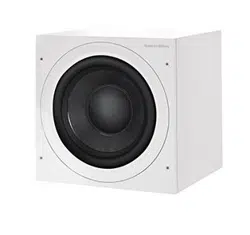Loading ...
Loading ...
Loading ...

13
• The VOLUME (SPEAKER) control (Item 4 in Figure 1)
• The LOW-PASS FREQ (frequency) control (Item 5
in Figure 1)
• The LOW-PASS FILTER switch (Item 6 in Figure 1)
Note: This applies only to the LINE input. The filter
is always in circuit with the SPEAKER LEVEL input.
• The BASS Extension switch (Item 7 in Figure 1)
• The EQ (equalisation) switch (Item 8 in Figure 1)
• The PHASE switch (Item 9 in Figure 1)
The appropriate settings depend on the equipment
used with the subwoofer and the modes of
connection. If using more than one subwoofer, ensure
the controls on each one are set the same.
Note: The VOLUME (LINE) and VOLUME (SPEAKER)
controls only operate on their respective line and volume
inputs. An unused volume control is best set to Min.
Home Theatre Settings
Set the VOLUME (LINE or SPEAKER) control initially to
the 9 o’clock position.
Set the LOW-PASS FILTER switch to OUT.
Set the EQ switch initially to position A.
Set the PHASE switch initially to 0°.
Set the LOW-PASS FREQ (frequency) control to 140 if
the speaker level inputs are used. The setting is
irrelevant if the line level inputs are used.
See the “Fine Tuning” section for more.
The subwoofer is not a THX
®
licensed component, but
may be used with a THX
®
controller if desired. If a
THX
®
controller is used, ensure that the subwoofer
function is enabled. This incorporates all the filtering
and level setting required for the subwoofer in all
modes. For level calibration, the internal test noise and
channel level controls in the THX
®
controller should be
used. In all cases the levels should be set to obtain
75dB SPL (C-weighted) at the listening position from
the controller’s internal noise test signal.
With other processors, configure the front and
surround speakers to “large” or “small” as appropriate
before setting the levels. Use the internal noise test
signal and volume controls of the processor to set the
levels of all the speakers. Only change the VOLUME
control on the subwoofer if there is not enough range
in the processor to achieve the correct levels.
Inexpensive sound level meters are readily available
from electronics stores and can be used to calibrate
the levels. Refer to your processor manual for further
details on how to set the levels.
2-channel Audio Settings
Set the VOLUME (LINE or SPEAKER) control initially to
the 9 o’clock position.
Set the LOW-PASS FILTER switch to IN.
Set the EQ switch initially to position A.
Set the PHASE switch initially to 0°.
Set the LOW-PASS FREQ control to match the -6dB
low frequency cut-off frequency of the satellite
speakers. Note: Both -3dB and -6dB figures can be
found in the specification of each B&W speaker
model. If the satellite speaker manufacturer quotes
only a -3dB frequency, the optimum setting for the
LOW-PASS FREQ control should be between 0.6 and
0.9 times that figure. The more gradual the low
frequency roll-off of the satellite speakers, the lower
the frequency should be set.
See the Fine Tuning section for more.
Fine-tuning
Home Theatre
In home theatre systems, the subwoofer (LFE) signal is
a separate channel rather than an extension of the
signal to the satellite speakers. The LOW-PASS
FILTER is switched out (or set to maximum), because
the processor provides all the filtering for any speakers
set to “small”. However, the position of the PHASE
switch must still be assessed. Normally the phase will
be set to 0°, but if the subwoofer is positioned at a
distance significantly different from the other speakers,
or the power amplifier driving the other speakers
happens to invert the signal, the 180° position may be
preferable. Listen with the switch in both positions and
choose the one that gives the fullest sound. If there is
little difference, leave the switch at 0°.
Surround sound processors normally have a calibrated
noise signal that can be used to set the relative levels
of all the speakers, making the task somewhat more
straightforward than for 2 channel audio. However, do
not be afraid to alter the settings to your personal
preference. It is all too easy to get carried away with
the capabilities of the subwoofer, especially with some
special low-frequency effects. Often a more realistic
portrayal, and one more satisfying in the long term, is
to be had by setting the subwoofer level lower than
the standard calibration level.
2-channel Audio
Set the system up in the preferred position and play
some programme with a steady bass content.
The optimum settings of the PHASE switch and the
LOW-PASS FREQ control are inter-related and also
dependent on the low-frequency cut-off characteristic
of the satellite speakers. However, the settings
recommended above for the LOW PASS FREQ control
and PHASE switch have been chosen to integrate well
with most satellite speaker bass alignments.
Using the initial settings, first check the setting of the
PHASE switch. Choose the option that gives the fullest
sound. Normally the recommended option will be
optimum, but may not be in certain circumstances.
These may be that the power amplifiers feeding the
satellite speakers invert the signal or that the
subwoofer is not placed close to the satellite speakers.
Next, adjust the VOLUME (LINE or SPEAKER) of the
subwoofer relative to the satellite systems to your
liking. Use a wide variety of programme material to get
an average setting. A setting that sounds impressive
on one piece may sound overpowering on another.
Listen at a realistic volume level as the perception of
musical balance varies with sound level.
7276 608_610_610XP no warra.qxd 20/5/13 1:04 pm Page 13
Loading ...
Loading ...
Loading ...
